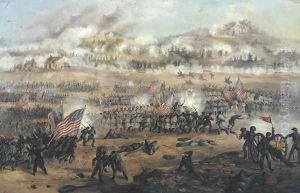Frederick Cavada Paintings
Federick Cavada was born on December 8, 1831, in Cienfuegos, Cuba. Though he is not primarily known as an artist, Cavada had a multifaceted life that included roles as a soldier, diplomat, author, and engineer. His artistic contributions, while not as well documented as his other endeavors, are part of the broader tapestry of his diverse pursuits.
Cavada moved to the United States at a young age and was educated in Philadelphia, Pennsylvania. When the American Civil War broke out, he joined the Union Army and served with distinction. He became a lieutenant colonel in the 114th Pennsylvania Infantry, a part of the famed Zouave brigade, known for their distinctive North African-style uniforms and drill techniques.
During the war, Cavada was captured by Confederate forces at the Battle of Gettysburg in 1863 and was held as a prisoner of war. He used his time in captivity to create illustrations and write, documenting his experiences with a sharp eye for detail. After his release in a prisoner exchange in 1864, he published a memoir titled 'Libby Life: Experiences of A Prisoner of War in Richmond, VA, 1863-64,' which included his own illustrations, giving insight into the conditions of Confederate prison camps.
Following the war, Cavada returned to his native Cuba and became involved in the struggle for Cuban independence from Spain. He was appointed as a diplomat and also engaged in engineering projects. However, his commitment to Cuba's independence led him to take up arms again; he served as a general in the Cuban Liberation Army.
Unfortunately, Cavada's life was cut short when he was captured by Spanish forces during the Ten Years' War. He was executed by a firing squad on July 1, 1871, becoming a martyr for the Cuban independence cause.
While Frederick Cavada's artistic output may not have been his most renowned contribution, his sketches and written works provide valuable historical insights into the period in which he lived. His life story reflects the broader narratives of the 19th-century struggles for independence and civil rights, intersecting with his personal expressions through art and literature.
